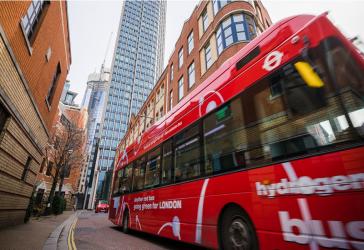
When the general public hears about hydrogen, it is usually in reference to fuel cell electric vehicles (FCEVs). And while sales of these vehicles are predicted to rise, hydrogen is actually forecast to have a far greater impact on long-haul freight, shipping, public transportation, and potentially aviation, where the limited range and efficiency of the batteries used in battery-powered electric vehicles (BEVs) are unsuitable.
Hydrogen’s potential as an emissions-free energy carrier goes far beyond transport applications, offering the prospect of an alternative to fossil fuels which could help decarbonize hard-to-abate sectors, such as heating systems and industrial processes.
Advances in transport represent one of the first steps towards realizing a hydrogen economy.
Public transport
Many parts of the world are already embracing hydrogen-fuelled public transportation. In 2018, Germany achieved a global first by bringing two hydrogen trains into service, replacing existing diesel-powered engines; a further 14 trains are due to begin operations by 2021.
The UK is considering investing in a network of hydrogen trains as it seeks to phase-out its diesel rolling stock; this approach would be just as green, but more cost-effective, than overhead electrification.
As part of plans to embrace a hydrogen-powered transport sector, Germany is building a 1 megawatt (MW) fuel cell to generate enough emissions-free hydrogen to power a fleet of FCEV buses in the city of Wuppertal. Hydrogen FCEV buses now operate in many European countries, the U.S., Japan, South Korea and China.
Aviation
The International Energy Agency (IEA) identifies hydrogen-based synthetic fuels as a potential solution for lowering emissions in aviation.
Electrifying the sector isn’t easy, as batteries are heavy and can compromise an aircraft’s power-to-weight ratio. Batteries also provide limited range, leaving several challenges to overcome to make electric flight a viable alternative for commercial operators.

Hydrogen-derived biofuels have the potential to allow the aviation sector to fly larger and longer, with no emissions.
A project under consideration in the Netherlands would build a 60 MW electrolyzer powered by North Sea offshore wind farms, to create hydrogen that would be converted to methanol and combined with cooking oil to produce 100,000 tonnes of aviation biofuels per year.
For long-haul freight, either on road or by sea, hydrogen is predicted to be able to play a role both directly, in the form of FCEV trucks, and indirectly, by being converted into ammonia as a shipping fuel.
Shipping
The UN’s International Maritime Organization (IMO) has set a target for the international shipping industry to halve its greenhouse gas emissions by 2050. With battery technology currently only a viable solution for short journeys such as ferry crossings, alternative approaches are being sought to decarbonize the sector.
As Mitsubishi Heavy Industries (MHI) Group’s new ebook on Hydrogen explains, it is expected that the IMO’s emissions targets will drive demand for ammonia as a low-carbon shipping fuel. Ammonia can be made from hydrogen and is a denser gas, providing a potential solution for the shipping of hydrogen in large volumes. If pressurized at room temperature, ammonia becomes a liquid in the same manner as liquefied petroleum gas (LPG).
This means that it is relatively easy to design and build new ships to handle either LPG or ammonia. Mitsubishi Shipbuilding has already built a multi-gas carrier capable of holding LPG and ammonia. It is also developing a concept ship — the LCO2 Carrier Cool Blue — capable of carrying liquefied CO2 captured by carbon capture facilities. This will make carbon capture possible in places where there may not be any suitable storage sites.
Solutions like these mean the world is already travelling towards a hydrogen economy, which could arrive sooner than you might think.
Source : https://spectra.mhi.com/planes-trains-and-ships-hydrogens-role-in-transport
